* We hiked the Inca Trail and visited Machu Picchu on April 28, 2015 – May 3, 2015
The Inca freaking Trail, Machu f–ing Picchu, the time had finally arrived! 4 backpacking/camping trips in 6 months so far and it was time to add a fifth; it was show time for the ultimate destination. Over the last 15 years I’ve had Machu Picchu at the top of my travel list. I have read books, watched documentaries, puzzled over theories and even talked with a family friend and amateur archaeologist who wrote a book about his own amazing discovery at Machu Picchu.
Jim Westerman, a friend of my dad, has an almost unbelievable story that he chronicles in his book, The Meaning of Machu Picchu. My dad and a small group of friends travelled with Jim to Peru in the late 90s to see his discovery, and ever since hearing my dad’s stories and seeing his photos, I have been intrigued by Machu Picchu and Incan archaeology. I have read Jim’s book twice and got Danny to read it as well before we went to dinner with Jim and his wife Trudey in Chicago last October before leaving on our adventure.
Jim visited Machu Picchu a few times in the 80s and early 90s and during one of his visits he awoke in the middle of the night with a vision of a cave underneath a rock in Machu Picchu called the Condor Rock. Jim was staying at the 1 hotel at the top of Machu Picchu mountain, just outside the entry gates to the ruins. So he woke up out of his dream and walked to the entrance. He managed to convince a night guard to let him in, and from there he walked in the dark to the ruins where he had a spiritual experience stemming from the visions in his dream. Over the course of the following 10 years he relentlessly researched, networked and wore down the Peruvian government, to eventually gain permission for a small dig in an area in Machu Picchu called the Condor Area. Before the dig, Jim and a Peruvian archaeologist had what I would call an Indiana Jones moment during which a light beam on the solstice shined through a space between 2 walls and directly into the area where Jim had his dream vision of the cave. Sure enough, excavations did reveal a cave that contained a skull, some crystals and other remnants that would indicate the cave was used for religious and sacrificial ceremonies. Jim believes that the cave connects to other caves underneath the ruins of Machu Picchu, and that the caves are astronomically aligned, however, he has unfortunately not gotten permission to test that idea through further excavations. Through his studies of Machu Picchu archaeology and the insight he gained by studying the artifacts found during his personal excavation, Jim believes that Machu Picchu was an important religious center for the Incan people. There are no written records that indicate exactly what Machu Picchu was, and there are a few theories that historians still debate. Jim’s book presents his Machu Picchu theory and is also a comprehensive history book on the ruins and how they connect to Incan and pre-Incan cultures. I was looking forward to finally seeing Machu Picchu for myself, and after all the hiking we’ve been doing lately, I was actually excited about the hiking part too.
Before we even left Chicago last October, Danny and I booked our Inca Trail to Machu Picchu hike, a 4 day/3 night trek that starts near the town of Ollantaytambo and meanders through the jungle, over the Andes Mountains, to Machu Picchu on a stone road built by the Incans as part of their vast network of of ancient roads. Danny was looking forward to the hike as well. He actually visited Machu Picchu 7 years ago but only on a day trip; he didn’t have time for the Inca Trail. Peru limits the number of Incan Trail hikers per day and permits typically book up many months in advance, so we did the research and decided that our last big adventure in South America would be a date with the Inca Trail, starting on April 28 and culminating with our arrival at Machu Picchu for sunrise on May 2, Danny’s birthday!
As it turned out, our pre-paying, pre-planning, and tour group research was well worth the price. We booked through a company called SAS Travel and wound up with a great group of fifteen fellow hikers, and 2 phenomenal guides. Our group could have been a disastrous mix of age and personality but somehow it all worked out! There were 3 British couples in their mid 60s who upon first glance, we thought hmm, how are these guys going to make it! But as it turned out, they were complete hiking machines who loved to drink and were great fun to hang with. There was a couple in their 40s from Flagstaff, AZ who were fun to talk to, and fast hikers as well. They were keen birdwatchers and got us excited about some rare birds we came across on the trail. We also bonded with 2 Cannucks around our age (1 of whom, through amazing coincidence, shared Danny’s birthday which was on the last day of our hike). Our lead guide, Hilberto, who called himself an amateur archaeologist, had hiked the Inca trail some ridiculous number of times, that I can’t even remember now how many he said. He had some great stories about looking for El Dorado, the rumored lost city of the Incas, and always sprinkled in some terribly cheesy jokes that matched the t-shirt he wore every day (that he also designed) that said “Take it easy, hold your llamas”. All kidding aside, Hilberto’s passion for Incan culture and for Machu Picchu was memorable and contagious. Ronnie, our other guide, was all muscle and a joker who understood our Spanish-speaking personality sense of humor. He didn’t speak a ton of English, but we enjoyed hiking with him and practicing our Spanish. He typically walked ahead with Danny and I as we powered through with what felt like superhuman hiking speed. Not bragging as we’re far from superhuman, but we had a distinct altitude advantage. The Inca Trail climbs to 13,800 feet above sea level, and since we were already well adapted to the altitude, having been in altitude for about a month by this point, we had a huge leg up over the rest of our group. Plus, we had porters carrying our heavy backpacks, so we were footloose and fancy free.
Rounding out our group were 17 incredible porters and 1 cook. Not only did they shlep camping equipment, food, cooking equipment and our personal belongings, but they were fast! We would see them pass us on the trail, running by with heavy loads and usually wearing locally made rubber sandals, instead of supportive hiking shoes like us gringos. They would beat us to the lunch spot each afternoon, set up a dining tent, help the cook prepare a delicious, multi-course lunch, and then pack it all up and still beat us to the overnight campsite at the end of the day! And by the time we made it to overnight campsite, our tents would already be set up with a multi-course dinner ready and waiting in the dining tent. They also had this one nice touch that may forever change the way I camp. They had plastic bowls of warm water waiting for each of so we could wash our face, or hands, what not. This was pampered trekking, I can totally admit that. I can also admit that I absolutely loved it. SAS Travel did a such a great job, and Hilberto made sure to recognize all of the porters and their hard work by introducing each one of them to us in a heartfelt appreciation ceremony on the first night.
The day to day routine during the Inca Trail trek consisted of early, pre-sun rise, wake ups, lots of hiking, early to bed, repeat. The trail wound up and down through cloud forest, cloud cover, fog, and a bit of rain, and parts of it were built into very steep hillsides. We saw sneak peaks of snow-covered, glacier-covered mountain tops in the distance when the fog cleared. Each day we passed through ruins of important Incan sites and cities, as well as giant sized Incan farming terraces. We would stop at each site for a lesson with Hilberto, during which he explained how the alignment of the trail, the glaciers and the ruins have helped archaeologists understand the significance and purpose of Machu Picchu. He was slowly, but enthusiastically, building us up to receive his own theory about the meaning of Machu Picchu. Danny and I were very appreciative of his knowledge and passion for archaeology. We have been on many guided tours during our trip so far and we haven’t always been so lucky with our guides.
It was truly a memorable hike, a perfect mix of history and breathtaking scenery. On our 4th morning in a row of the wake up early and hike routine our group felt such a sense of accomplishment, as together we reached the Sun Gate, the ruins of a lookout tower, giving us our first look at Machu Picchu, right at sunrise. Our whole group had made it, even with a few people nearly giving in to stomach ailments and altitude sickness. We hugged it out and reveled with the other hiking groups with whom we shared the phenomenally clear sunrise view over the picturesque ruins below.
We spent the rest of the morning touring the ruins and listening to Hilberto explain important areas and structures. The exhaustion we felt from 4 full days of hiking and early wake ups seemed to be put on hold as we were in awe of the city of ruins we had literally walked to. It was funny to walk around the site and spot the freshly showered tourists who had taken the bus up to the ruins versus us beat up and dirty hikers who hadn’t showered in days. Hilberto finally presented his theory on Machu Picchu, that he had been working us up to receive through all of our other talks during the trek. He believes that the difficult to reach, mountain top location was chosen because of its view to all 4 sacred Incan glaciers, one in each cardinal direction, which would make Machu Picchu the center of a sacred Incan compass. And because of this special location, he believes Machu Picchu was a spiritual center for the Incan people, a very similar theory to Jim Westerman’s.
Hiberto’s and Jim’s theories were hard to deny, as Machu Picchu clearly felt like a spiritual place to both Danny and I throughout our visit. The location alone is difficult to believe! The city of Machu Picchu sits on a magnificent, steep mountain top surrounded by a lush, high altitude jungle. It feels incredibly remote and difficult to reach. From the base of Machu Picchu mountain the peak and the ruins aren’t even visible. That means the local people in the village at the base lived with the ruins above them for hundreds of years before the site was even discovered. Throughout our hike and during our time at the site of Machu Picchu we were lucky enough to have clear breaks in the clouds to view each of the sacred glaciers in the far off distance. And the ruins, well if you’ve been reading our blog you know I love me some ruins, are spectacular. The structures of Machu Picchu are well built, have stood for hundreds of years and display the hallmark of Incan architecture, those perfectly shaped stone blocks that fit together with no space between, and no mortar either. How did those crazy Incans even find that perfect mountain top, and when they did, how did they get those stones up there!
After our morning at the ruins, our group headed down into Aguas Calientes, the village at the foot of Machu Picchu, by bus and had a farewell lunch together. Although the official trek was over, Danny and I had opted to stay the night in Aguas Calientes. After our first showers in 4 days, and a little bit of downtime, we felt energized enough to head out into town to celebrate Danny’s birthday. We wound up running into the older Brits from our group and they made room for us at their table for some happy hour drinks. They continued to buy us drinks and then invited us to join them for dinner. We stayed out later with them, drinking more than we had in weeks! We all laughed a ton, and we hope we are that fun when we are their age!
But Danny’s and my adventure at Machu Picchu wasn’t finished yet! We woke up early the next morning to head back up to the ruins by bus for a few hour hike of Wayna Picchu, followed by a morning and an afternoon stroll through the ruins. I was a bit more hungover than Danny, but we both pushed through and had a great hike on another amazingly clear day. Wayna Picchu mountain is a peak just beside Machu Picchu that has its own ruins and also great views of the surrounding mountains and ruins. The hike turned out to be really fun for us, with its narrow steps and rope supports, and it only took about 2 hours roundtrip. At the top there was a bit of a crowd, but we caught some amazing views of Machu Picchu city below as well as all of the grand farming terraces up and down Machu Picchu mountain. Again, we were completely wowed by the location of the ruins and how large the ancient complex had been.
After the hike we spent the rest of the day visiting a few other parts of the Machu Picchu ruins with a picnic break on an ancient farming terrace . We walked out to see the Inca Bridge, a stone bridge perilously built into a cliffside to connect 2 parts of the Inca Trail. Again, those Incans were crafty dudes. We also made a special visit to the Condor Area, where Jim Westerman made his discovery.
Unfortunately the cave that he discovered was not open for us to look into, but we saw that the area was roped off, so as to indicate that something special exists there. We spent some time observing the area, and the actual Condor Rock that really does look like a condor’s head and wings, and noticed that very few tour groups passed by. Although one tour guide I overheard speaking to his group in Spanish did briefly mention that an American discovered a cave beneath Condor Rock. That was pretty cool to overhear!
We wrapped up the day, with an early dinner back in Aguas Calientes. Danny finally found a restaurant where he felt comfortable ordering the cuy (guinea pig). He ate that little dude and left just a few tiny bones, after which he reported to me that it smelled worse coming out than going in. Enough said.
Here are a few other stories and highlights from our Inca Trail hike and time at Machu Picchu (although I think I wrote about most of the fun stuff above)…
- If you are interested in the hiking route we took, click here to see a map. The terrain varied day to day with a lot of ups and downs, and a few narrow, cliffside areas.
- The hardest part of the hike was Dead Woman’s Pass, a steep uphill climb to a rock formation that looks like a woman lying down, with pretty big boobs. We covered the same altitude climb as we had accomplished in Colca Canyon over a span of 4 hours, but on the Inca Trail we did it over the course of a whole day. We were the first in our group to make it up the pass and as each member of our group approached the top we cheered them on and greeted them with hugs.
- During the handful of long treks Danny and I have done over the last 6 months we have developed a style of hiking, thanks to an orientation we went to at a hostel before hiking the W in Chile, where we don’t bring out rain gear unless absolutely necessary. When we are wet and cold, we just hike faster and our body heat dries our clothes as we move. But there was a day on the Inca Trail when we had a ton of rain, pretty much all day, so we finally caved in and wore ridiculous, bright colored ponchos. Of course, the rain stopped shortly after we finally decided to put them on.
- During our last sunset on the Inca Trail we watched the sun go down from a large farming terrace complex above our campsite. It was a beautiful, misty sunset with ruins as far as the eye could see. We couldn’t believe that after seeing ruins all along the Incan Trail we were actually going to reach the whopper of them all by the time sun came up the next morning.
- On that last night the SAS crew had a birthday cake for Danny and Allan, the Canadian guy in our group with the same birthday. I couldn’t believe the porters schlepped a cake up the trail and it was still in perfect shape after 4 days! Danny and I had been carrying some rum so we divvied up what remained among the group for a small night cap before we all turned in early for our 3:30 AM wake up call.
- After we all watched the sunrise from the Sun Gate, Hilberto took our group to a special altar rock where incoming Incan pilgrims would make offerings before entering Machu Picchu. Hilberto lead us in an offering ceremony during which each of us got to make our own prayers and offer up any left over food or coca leaves we could muster. We wound up with a big pile of Oreos, soda crackers and coca leaves. It looked pretty funny but I made a wish that I hope will come true in the coming years…
- We had some time to kill while waiting for our evening train back to Cusco, so we wandered around the little town and happened across a local parade with men dressed in traditional costume with dead alpacas hanging from their backs. We also saw a dog dressed in a 70s style, polyester short sleeved, collared shirt. It was definitely more local color than we had expected to find in a village that has been taken over by the Machu Picchu tourism craze.
To see all of our photos from the Inca Trail and Machu Picchu on Flickr, click here.

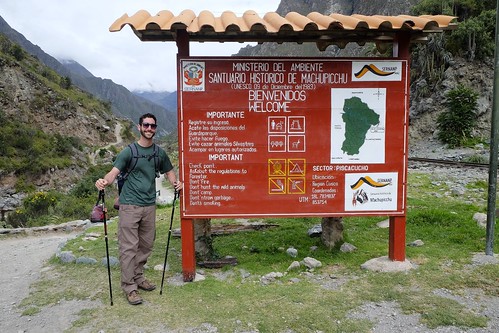
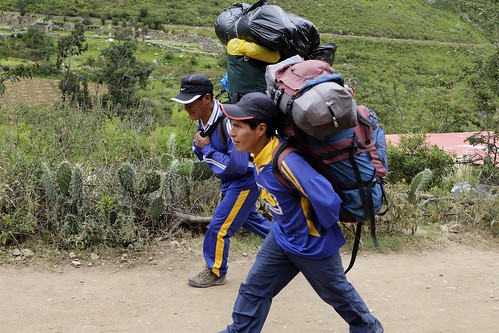

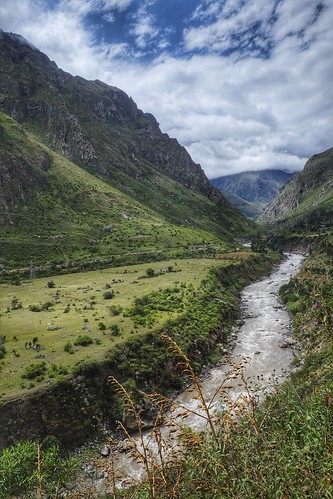

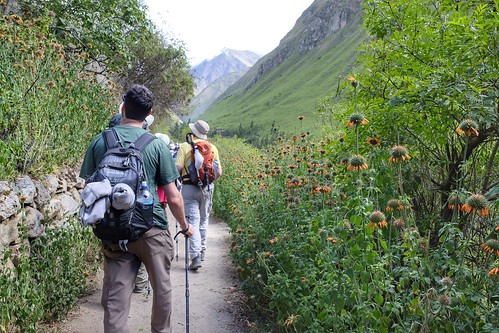
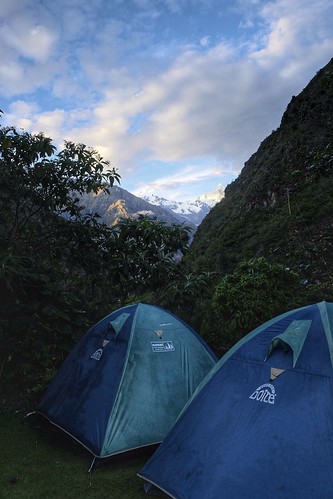

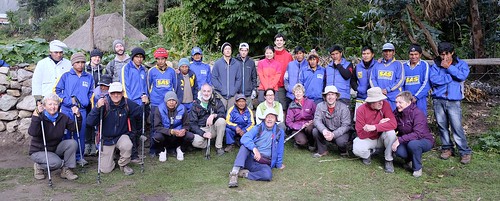
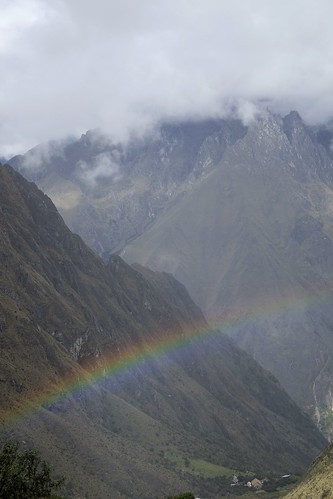
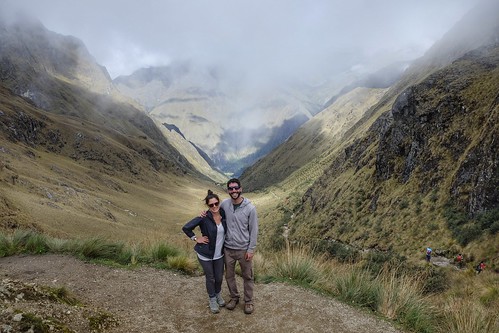

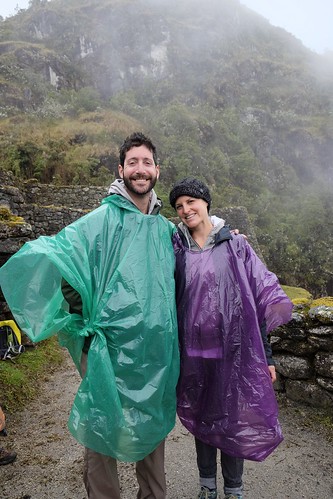
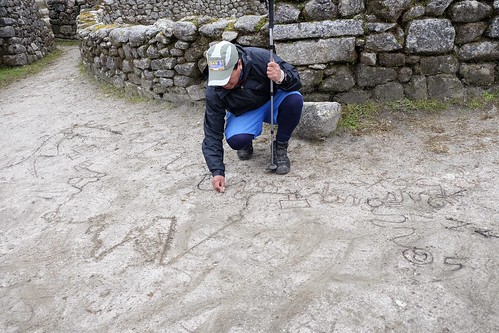

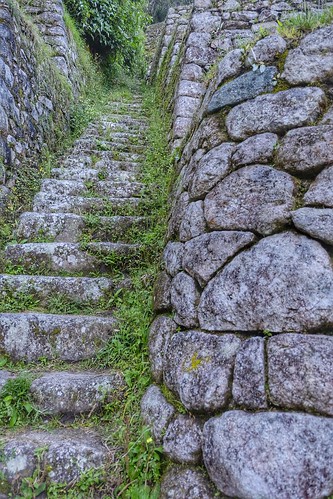
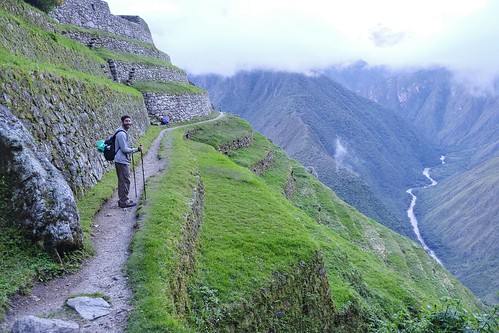
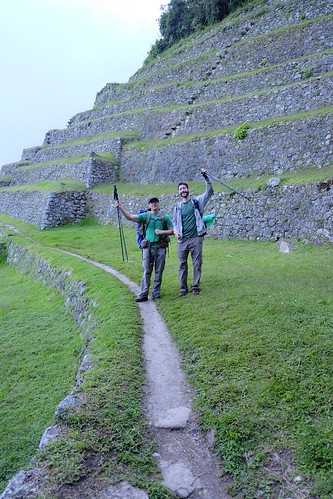
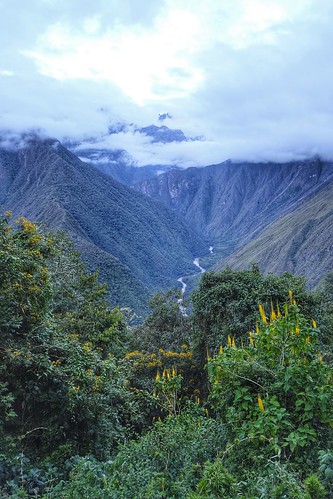

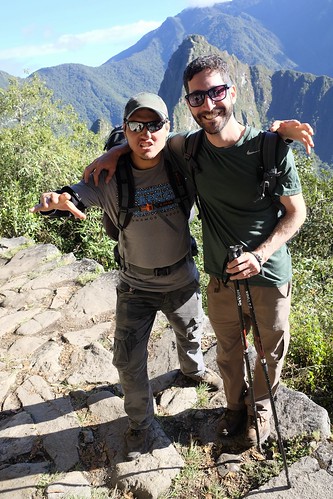
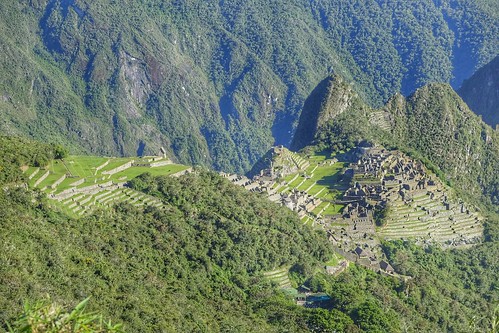

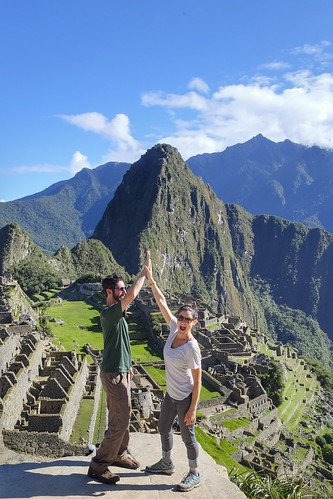

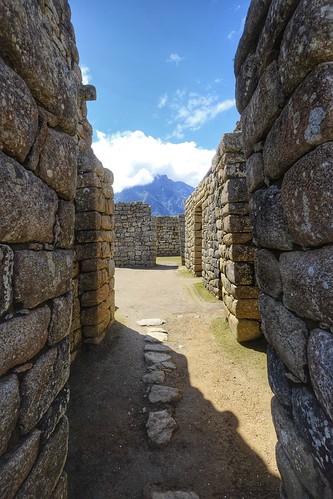
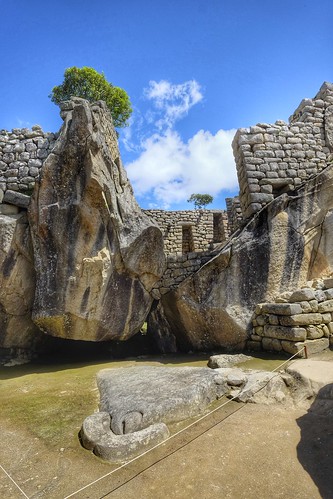
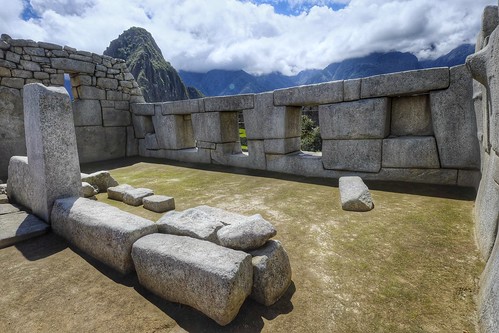
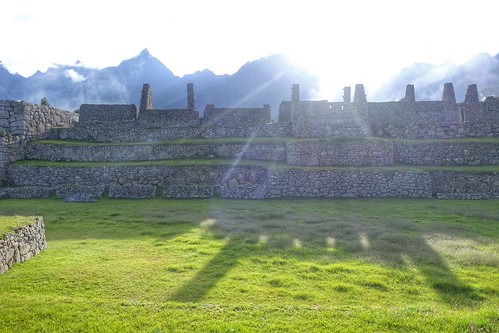
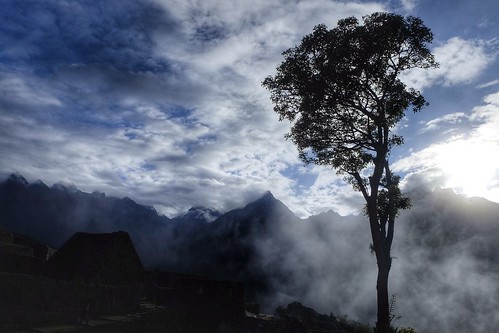
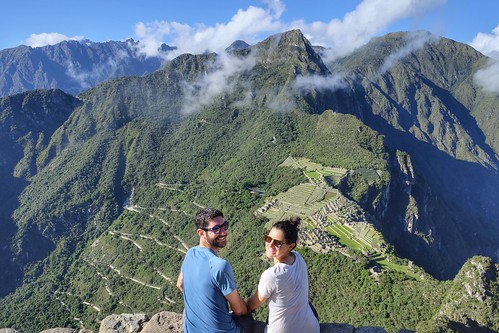
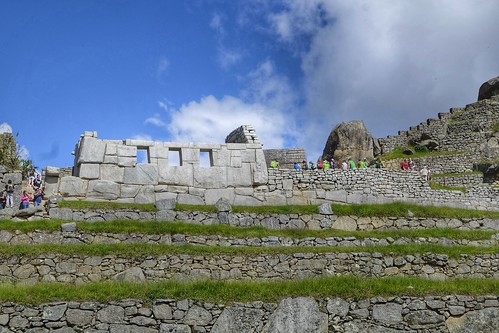
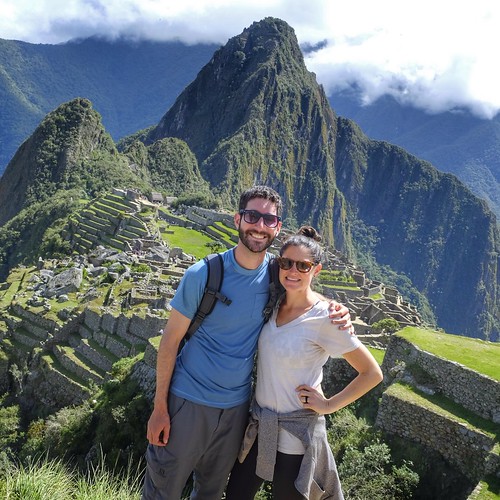
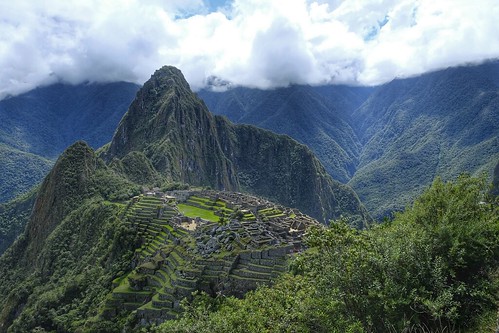

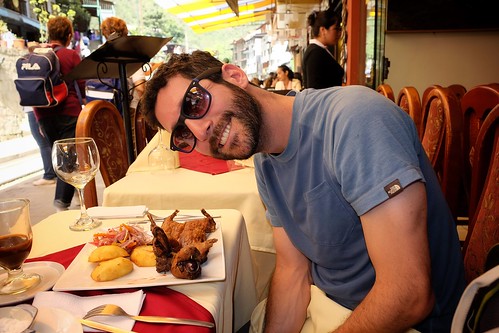
Wish Andy and I could have come with you on that one! Pictures were great! Pls tell Danny that elementary school classrooms keep guinea pigs as pets🐽🐽🐽. Miss guys and can’t wait to see you soon!! Xoxo
Loved, loved, loved this post! Been waiting for it! What a way to see it. I, of course, went by train and was one of the fresh showered group! Hope you’re enjoying Asia…. See you soon. Xxxx